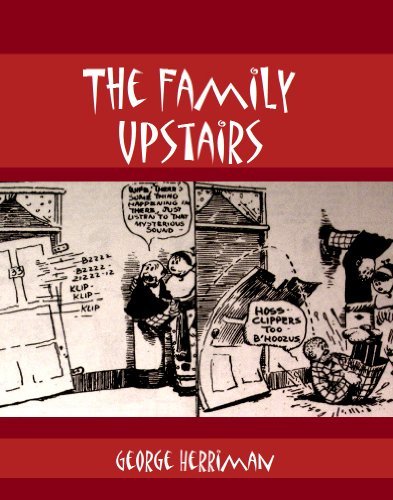The Dingbat Family (The Family Upstairs)
Reviewed by Peter Campbell 31-Mar-11
Before Krazy Kat there was The Dingbat Family. It was, in fact, the comic strip that gave birth to Krazy, who literally emerged from the margins of the strip to occupy his/her own series. Thanks to Fantagraphics, the Krazy Kat strips are readily available, but its progenitor is only very occasionally reprinted. That makes the appearance of this collection very welcome.
Before Krazy Kat there was The Dingbat Family. It was, in fact, the comic strip that gave birth to Krazy, who literally emerged from the margins of the strip to occupy his/her own series. Thanks to Fantagraphics, the Krazy Kat strips are readily available, but its progenitor is only very occasionally reprinted. That makes the appearance of this collection very welcome.
The strip revolves around the eponymous family and their neighbours. Of the Dingbats, the main players are E. Pluribus Dingbat, and his wife Polly. They have a running feud with the family who live in the flat above them, and who are unnamed, and unseen. The Dingbats are on a constant mission to defeat their neighbours, but no matter where they go, no matter what they do, their neighbours are there to annoy them.
It’s a simple set up, one that Herriman repeats with endless variations. In that respect it has strong similarities with Krazy, although in the later strip he’d stripped the formula down to almost skeletal elements, upped the surrealism and the invention, and in the process created the Citizen Kane of comics.
The Dingbat Family isn’t anywhere close to operating at that level. If Herriman had stopped at the moment of its creation, he’d be a footnote in comics history, not one of its keystones. At the same time it is recognisably Herriman: no-one else manages to create that scratchy, limited style that is at the same time extremely expressive.
The set-up in each strip, or series of strips, follows the same formula: the family upstairs manage to do something that annoys the Dingbats (especially E Pluribus, who definitely suffers from little man syndrome), and they attempt to solve the problem themselves, or with the assistance of others. Invariably, they’re foiled. The action is set around stock locations: the ceiling, the door, the stairwell, the umbrella stand, and the characters play out their comedy of errors around these props. Only occasionally do they escape from the confines of room and stairwell; and still their day manages to be ruined by their neighbours. You suspect Herriman’s sympathies lie more with the anarchic, unseen upstairs family than with the conventional lifestyle of the Dingbats.
Some of the set-up works very well: there is the appearance of a dim-witted detective, all decked out in black, who fails to realise that E Pluribus is the man he’s looking for, despite all the evidence invariably pointing in his direction; the mesmerist who only manages to summon a parrot. Other episodes are little more than rather feeble jokes where the outcome is as predictable as the set up.
Along the way there are some out and out surrealist touches: the menagerie of birds that appears to occupy the flat upstairs; the Olympic runners that come bursting out of the door to trample the hapless E Pluribus; the unexpected appearance of Wild Bill Hickok who tempts the Amerindians hired to terrorise the neighbours to join his show instead.
It’s also, in places, as racist as you might expect a comic strip of its time to be. There are lazy, unemployed blackface negroes, Amerindians who invariably succumb to the lure of drink, slant-eyed Chinese laundymen who speak in less than pidgin English. Even considering that such depictions were the norm, you would expect a little more insight from a man who was himself of mixed race.
Even with its flaws, it’s still interesting and engaging to read, partly because you know what was to follow. There’s a character from Coconino County, three separate characters called Ignatz, and one of the occupants of the upstairs household is a stork. No, it’s not Krazy, but you can see the development of his thought processes in getting there, and that’s much of the attraction of reading this strip.
All of which brings us to this publication. Only available in Kindle form, it’s a rather shoddy collection of poorly scanned strips, one strip a page, with varying levels of legibility, occasionally degenerating into illegibility. For a couple of pounds, I can’t complain too much, but I’d hardly recommend this to anyone wanting to sample Herriman’s work for the first time. Hopefully another publisher will bring out a collected edition that treats the material here with the respect it deserves, but in the meantime this is an intriguing but really very inadequately produced taster.
Tags: Amazon, George Herriman, Kindle, Krazy Kat, newspaper strips, The Dingbat Family, The Family Upstairs
– thanks for the tip, peter – i shall definitely check this out
( i’m a bit of a kindle addict since i got one for xmas )